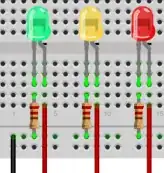So I'm making a model that simulates traffic lights (Red, Amber, Green) so there will be three LEDS that need to be preferably extendable (I don't want them attached directly to the breadboard) but I don't even know where to start (Ok, I admit I am pretty new to all of this but do want to learn!)
Basically, I have read somewhere that I can purchase the following:
- 26 pin ribbon cable
- Custom PCB
- Ribben cable socket
- Header pins
But the problem is that I don't really want a 26 pin ribbon cable because it would just look ugly in the model. Instead I was just thinking about soldiering the PCB onto the breadboard and using (breadboard wires) connect the Pi up to the breadboard, have resistors and then finally connect the LEDS. Does this sound practical?
Hope someone can help me! :)
